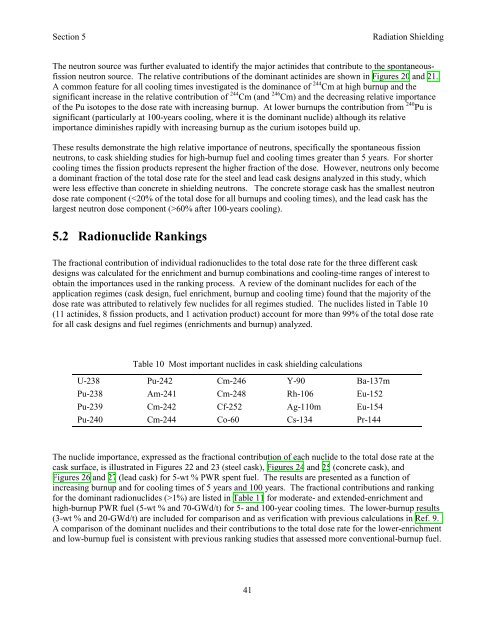nureg/cr-6700 - Oak Ridge National Laboratory
nureg/cr-6700 - Oak Ridge National Laboratory
nureg/cr-6700 - Oak Ridge National Laboratory
You also want an ePaper? Increase the reach of your titles
YUMPU automatically turns print PDFs into web optimized ePapers that Google loves.
Section 5<br />
Radiation Shielding<br />
The neutron source was further evaluated to identify the major actinides that contribute to the spontaneousfission<br />
neutron source. The relative contributions of the dominant actinides are shown in Figures 20 and 21.<br />
A common feature for all cooling times investigated is the dominance of 244 Cm at high burnup and the<br />
significant in<strong>cr</strong>ease in the relative contribution of 244 Cm (and 246 Cm) and the de<strong>cr</strong>easing relative importance<br />
of the Pu isotopes to the dose rate with in<strong>cr</strong>easing burnup. At lower burnups the contribution from 240 Pu is<br />
significant (particularly at 100-years cooling, where it is the dominant nuclide) although its relative<br />
importance diminishes rapidly with in<strong>cr</strong>easing burnup as the curium isotopes build up.<br />
These results demonstrate the high relative importance of neutrons, specifically the spontaneous fission<br />
neutrons, to cask shielding studies for high-burnup fuel and cooling times greater than 5 years. For shorter<br />
cooling times the fission products represent the higher fraction of the dose. However, neutrons only become<br />
a dominant fraction of the total dose rate for the steel and lead cask designs analyzed in this study, which<br />
were less effective than con<strong>cr</strong>ete in shielding neutrons. The con<strong>cr</strong>ete storage cask has the smallest neutron<br />
dose rate component (60% after 100-years cooling).<br />
5.2 Radionuclide Rankings<br />
The fractional contribution of individual radionuclides to the total dose rate for the three different cask<br />
designs was calculated for the enrichment and burnup combinations and cooling-time ranges of interest to<br />
obtain the importances used in the ranking process. A review of the dominant nuclides for each of the<br />
application regimes (cask design, fuel enrichment, burnup and cooling time) found that the majority of the<br />
dose rate was attributed to relatively few nuclides for all regimes studied. The nuclides listed in Table 10<br />
(11 actinides, 8 fission products, and 1 activation product) account for more than 99% of the total dose rate<br />
for all cask designs and fuel regimes (enrichments and burnup) analyzed.<br />
Table 10 Most important nuclides in cask shielding calculations<br />
U-238 Pu-242 Cm-246 Y-90 Ba-137m<br />
Pu-238 Am-241 Cm-248 Rh-106 Eu-152<br />
Pu-239 Cm-242 Cf-252 Ag-110m Eu-154<br />
Pu-240 Cm-244 Co-60 Cs-134 Pr-144<br />
The nuclide importance, expressed as the fractional contribution of each nuclide to the total dose rate at the<br />
cask surface, is illustrated in Figures 22 and 23 (steel cask), Figures 24 and 25 (con<strong>cr</strong>ete cask), and<br />
Figures 26 and 27 (lead cask) for 5-wt % PWR spent fuel. The results are presented as a function of<br />
in<strong>cr</strong>easing burnup and for cooling times of 5 years and 100 years. The fractional contributions and ranking<br />
for the dominant radionuclides (>1%) are listed in Table 11 for moderate- and extended-enrichment and<br />
high-burnup PWR fuel (5-wt % and 70-GWd/t) for 5- and 100-year cooling times. The lower-burnup results<br />
(3-wt % and 20-GWd/t) are included for comparison and as verification with previous calculations in Ref. 9.<br />
A comparison of the dominant nuclides and their contributions to the total dose rate for the lower-enrichment<br />
and low-burnup fuel is consistent with previous ranking studies that assessed more conventional-burnup fuel.<br />
41

















